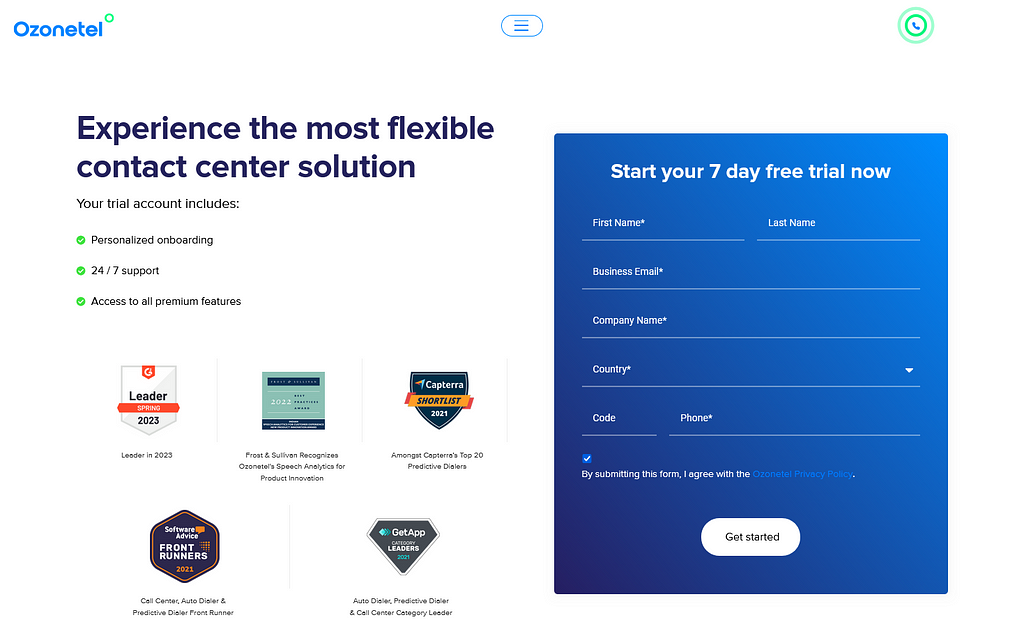- Resources
- Customer Service Excellence in the Banking Industry
Customer Service Excellence in the Banking Industry

Banks that continually improve the customer experience expand 3.2 times faster than competitors that do not. And, with more than half of consumers saying they will switch to a rival after a single disappointing interaction, customer service has never been more crucial in any industry.
But how do you design experiences that are relevant, helpful, and safe enough to attract new bank customers? According to research, 53% of customers are frustrated when they are unable to respond to a mobile message, indicating that they are ready for two-way, real-time engagements that fix their problems instantaneously, regardless of location.
So, are you convinced about the need to boost your customer service experience? If yes, then read along as we discuss different ways to deliver excellent banking customer service along with examples of banks that have aced their customer service game!
In this article, we will explore:
- 1. What is Customer Service in Banking?
- 2. The Importance of Efficient Customer Service in the Banking Industry
- 3. Examples of Good Customer Service In Banking
- 4. Leading rural NBFC Automates 5 Million Reminder Calls
- 5. Leading NBFC Optimizes Sales & Delivers Efficient Customer Services
- 6. A Leading Stockbroker Effectively Manages High Call Volumes & Volatility
- 7. Tools Bank Can Use to Improve Customer Service
- 8. How to Improve Customer Service in Banking
- 9. How Ozonetel’s Improves Superior Banking Services
What is Customer Service in Banking?
Financial institutions have some of the highest customer acquisition costs in the market today. Acquiring new clients can cost five times as much as keeping old ones. As a result, it is critical to implement effective customer service techniques in the banking industry.
But what does customer service mean? Excellent customer service in banking involves providing individualized financial solutions and support that not only meet but surpass customers’ expectations. It is the foundation for developing trust and remaining competitive in an increasingly changing economy.
Furthermore, customer service means different things in different businesses, but it always comes down to the same fundamental element: offering exceptional levels of service to your clients.
In practice, great customer experience in banking entails a deep understanding of customer needs and preferences, fostering strong and lasting relationships.
Heightened emphasis on customer service: As customer preferences evolve, competitors recognize proactive customer service as a pivotal tool for distinguishing their offerings in the market.
Evolving customer expectations: Modern customers exhibit higher levels of discernment and expect more from their banking experiences compared to three decades ago.
Emphasis on relationship strategy: It’s imperative to develop, implement, and monitor a customer service strategy that not only adds value for customers but also plays a central role, rather than being overshadowed by other elements of the marketing mix.
The Importance of Efficient Customer Service in the Banking Industry
According to The State of Contact Center Report 2023-24 by Ozonetel, 20% of customers abandoned their call underscoring the need for efficient customer service in banking. Here are seven points highlighting why customer service in banking matters.
Improves Customer Retention
Efficient customer service plays a vital role in retaining customers, saving on the high costs associated with acquiring new ones in the banking sector.
Provides Competitive Advantage
84% of businesses focusing on enhancing customer service reported an increase in revenue. This strategic customer focus provides them with a notable edge in the competitive banking landscape.
Increases Customer Satisfaction
A global survey showed a customer service satisfaction rating in banking industry of 3.82 out of 5, indicating its significance. The survey conducted in 32 nations worldwide revealed that consumers in general were satisfied with the customer services offered by their banks.
Builds Brand Reputation
Exceptional customer service not only enhances a bank’s reputation but also acts as a magnet for attracting new customers, bolstering its market standing. Good customer service makes people view a brand positively, while bad experiences can harm a brand’s reputation and lead to customer churn.
Enables quick Problem-solving
Swift and effective problem-solving is crucial for ensuring higher customer satisfaction, building trust, and fostering long-term customer loyalty within the banking industry.
These points underscore the importance of online customer service in the banking industry today. It’s clear that banks must prioritize improving their customer service strategies to meet the evolving needs and expectations of their clients.
Examples of Good Customer Service In Banking
Banks today rely heavily on strong customer service to retain clients and build brand value. Here are three examples of banks providing excellent service through the smart use of technology:
A Leading Private Bank Efficiently Manages 1 Lakh Calls With Only 500 Agents & Improves CX
Our client, one of India’s premier banks serving around 40 million customers, efficiently manages over 1 lakh calls daily with just 500 agents through an AI-powered contact center solution. The platform provides capabilities like call monitoring, real-time analytics, and auto callbacks to ensure 100% call attendance around the clock. This optimized infrastructure has halved capital expenditures related to legacy systems for the bank.
Self- Service IVR: Simple transactions such as reordering rolls are managed completely via Self-service IVR
Auto callbacks using Idle agent: Any call disconnected while waiting in queue is automatically re-dialled and patched to an agent whenever Agent is idle
Auto routing: Based on caller DID number, IVR auto divert call to the nearest local support center
Call monitoring: Track calls taking place anywhere across 36 geographies in real time and generates 70+ reports across multiple parameters
Moreover, customers also benefit from quicker query resolutions without hassles like repeated re-dialing during peak times. The automated system has been instrumental for our client in improving customer satisfaction through prompt service.
Leading rural NBFC Automates 5 Million Reminder Calls
Leading rural NBFC Automates 5 Million Reminder Calls
Our client, a rural NBFC with more than 1000 branches across India, uses Ozonetel solutions to automate 5 million monthly personalized loan repayment reminders through an integrated interactive voice response (IVR) solution.
A personalized approach: Every call is personalized with customer <name> and <amount due> in a 100% automated process with no human intervention.
Contextual Messages: The solution extracts relevant customer data from Mahindra Finance’s CRM and relays unique, contextual voice messages personalized with embedded customer details.
Timely Reminders: This saves over 50% manual effort previously spent on calling borrowers individually while ensuring timely, consistent payment reminders.
The data-driven, personalized outreach has made the process smooth, fast, and effective for the NBFC. Communication touchpoints are consistent while costs are lowered, enabling staff to focus on value-adding tasks.
Leading NBFC Optimizes Sales & Delivers Efficient Customer Services
One of India’s top NBFC leveraged Ozonetel’s Unified CX platform to automate sales calls to leads and accelerate the responsiveness of their customer service, reduce agent workloads, create stellar self-service, and streamline the monitoring of agent activity across geographical locations
Intelligent IVR System: Implemented a multi-level, multi-lingual IVR system automating 50% of inbound queries, including account statements and payment inquiries, enhancing customer service efficiency.
Real-Time Agent Monitoring: Tracks agent activity across Pune, Kolkata, Chennai, and Bengaluru through a unified dashboard, optimizing resource allocation and improving service quality.
Auto Call Disposition: Eliminated manual call disposition handling, reducing after-call work time by 75% from 2 minutes to just 32 seconds, enhancing agent productivity and efficiency.
Increased Sales Calls: Reduced agent workloads resulted in the completion of 10 lakh sales calls monthly, demonstrating significant improvements in sales operations and outcomes.
A Leading Stockbroker Effectively Manages High Call Volumes & Volatility
A leading stockbroker uses Ozonetel’s CCaaS solution to ensure high uptimes even during peak loads. With intelligent IVR, callbacks, and supervision they efficiently managed the entire operations in a cost-effective virtual setup.
Ensuring High Uptimes: With Ozonetel, the firm could handle 40,000+ calls daily and up to 1340 calls concurrently. They also created redundancies and took fail-safe measures to mitigate telecom outages.
Customer-centric IVR : A self-service IVR further automated 35-40% of all incoming calls, reducing the need for agent intervention. Consequently, wait times decreased so significantly that abandon rates fell by 58%
Priority-based Callbacks: In case a call drops while in queue or during conversation with an agent, the customer receives an automated, priority-based callback
Seamless Remote Working: Ensured uninterrupted business continuity by directly patching calls to agents’ mobile phones. Supervisors used Ozonetel’s Call Monitoring Dashboard, Darwinbox integration, and Rogue Agent features to ensure high productivity and discipline
Compliant & Secure : Call recordings & secure storage ensure compliance with SEBI’s mandate of maintaining legally verifiable records of clients’ orders. And integrated dialers improve the efficiency of outbound calls.
Tools Bank Can Use to Improve Customer Service
Banks today have a wide range of technologies at their disposal to enhance the customer experience and improve satisfaction. By leveraging the right tools, banks can provide faster, more convenient service across channels. Here are some of the top technologies banks should consider to boost their customer service capabilities:
Robust Telephony Infrastructure
Upgrading telephony with features such as IVR, speech recognition, and call routing can help efficiently direct customer calls to the right agents. This speeds up resolutions and enables 24/7 self-service options.
Self-service IVR
Self—service IVR streamlines customer service by providing quick access to information and services, reducing wait times and empowering customers to resolve queries independently, enhancing overall satisfaction and efficiency.
Omnichannel Support
Meeting customers on their channel of choice – whether phone, email, chat, social media, or in-person – requires an omnichannel service strategy. Banks should integrate channels through CRM platforms so customer data and conversations flow seamlessly between areas.
Intelligent Chatbots
AI-powered chatbots offer customers self-service for common inquiries on bank websites and mobile apps. When paired with human agents, chatbots become more effective at resolving a wide range of customer needs.
Voice Bots
Similar to chatbots, voice bots accessed through the phone use natural language processing to handle routine customer requests without requiring human intervention – like checking balances or transaction status.
Data Analytics
Using data analytics and customer relationship history, banks can deliver tailored product and service recommendations to website visitors or mobile app users to enhance digital experience.
Co-Browsing Software
Visual engagement tools allow agents to see a customer’s screen and guide them through processes like account openings or online payments, improving comprehension and outcomes.
How to Improve Customer Service in Banking
In the banking industry, delivering exceptional customer service may seem daunting, but it’s achievable with the right mix of digital infrastructure, technology, and tools, centered around automation, artificial intelligence, and interoperability.
1. End-to-End Integration
The words “seamless” and “omnichannel” get thrown around a lot. What this really means is that information and digital instructions must freely pass throughout the entire system. This is what enables consistency, personalization, and automation. It unifies digital channels, allowing your bank to tap into new service models and value generators. Secure digital infrastructure enables customer engagement tools like customer self-service chatbots, text messaging, and mobile notifications.
But cohesion centered within a single platform is even more critical for service representatives. This is what gives them a comprehensive view of the customer’s relevant information and prior service interactions.
2. Smarter Automated Phone Service
How natural is your bank’s automated interactive phone menu? What kind of first impression does it give banking customers? The interactive voice response system is on the frontlines of customer service. Yet, it’s often treated as an afterthought. Banks that expect customers to put up with a poor IVR are in for trouble. It should be held to the same standard as a living receptionist. Give customers an experience that’s as close to speaking with another human being as possible. One step is to avoid IVRs that rely on dial pad input or ones that can only recognize stilted “yes” or “no” voice answers.
Look for one that incorporates artificial intelligence with sentiment analysis. This IVR will understand what the customer says and means, then respond in a human-like way. It’s an easy and effective way to improve customer service in banks.
3. Call Automation
Smart banking auto-dialers are essential for efficient outbound customer service. It will analyze the customer’s profile, match them with the right representative, and automatically dial them. While that’s happening, banking representatives can start filling themselves in on the customer’s details. And they should have this at their fingertips. It can be pulled from the banking CRM system or referenced from the calling software’s contextual contact information tool.
Auto dialers should also be used to deliver automated bank messages, notifications, authentication notices, and account information.
4. AI Assistance
Offer customers assistance from artificial intelligence on as many touchpoints as possible. It’s a practical method for lowering representatives’ workloads and necessary for guiding customers through new digital experiences. The first point of contact rarely needs to be a live representative. A self-service chatbot with conversational AI can serve as a customer guide and virtual information center, delivering answers to FAQ, account information, and service updates.
5. Sentiment Awareness
Exceptional banking customer service is done through effective customer sentiment analysis. And our software has advanced enough to understand human sentiment. Countless customers have been put off by a cold, unfeeling automated bank service. One that forces them through a long sequence during a time-sensitive crisis. Or responds to increasing frustration with the same script and a rage-inducing chipper tone. Software isn’t truly aware. But it can detect things like speech rate fluctuations, voice tone, speech volume, red flag keywords, and even breathing patterns. And it can interpret the meaning behind these factors.
6. The Human Touch
No matter how digital or AI-based customer service gets, everything must be oriented towards providing a very human experience. This is the final element needed for customer service excellence in the banking industry. Customers are seeking human connection in service. This is a deep-seated need that’s driven by pandemic anxieties and frustrations. And their financial matters are a particularly sensitive area that needs to be handled right.
For example, potentially unpleasant debt collection calls can now be swapped out for less confrontational AI voice bots who can negotiate payment plans without embarrassment or pressure. Tomorrow’s leading banks are the ones who use this time to build trust and actively cultivate relationships while implementing creative new service models and stronger digital infrastructure.
How Ozonetel’s Improves Superior Banking Services
Ozonetel’s Contact Center as a Service (CCaaS) offers a comprehensive solution to enhance banking services, leveraging cutting-edge technology and seamless integrations.
Enterprise-grade Cloud Contact Centers
Ozonetel’s CCaaS provides secure cloud contact centers with robust data security and consistent uptimes. Our enterprise call center software ensures uninterrupted service delivery, vital for maintaining customer trust and satisfaction.
Automation & Conversational AI
Improve debt recovery and collections processes with automated alerts, calls, and appointment scheduling powered by advanced conversational AI. This streamlines operations and enhances efficiency in handling customer inquiries.
Virtual Relationship Manager Solutions
Efficiently route customer calls and messages to the appropriate relationship manager, ensuring personalized interactions and maintaining consistency with masked caller IDs. This fosters stronger customer relationships and enhances overall service quality.
Dependable Remote Working Solutions
Enable effective management of remote teams with intelligent routing, call forwarding, and advanced live monitoring dashboards. These features facilitate seamless collaboration and ensure high-quality customer service, regardless of team location.
Seamless Integrations
Leverage deep CRM integrations to personalize conversations, prioritize high-value customers, and tailor offers to individual needs. This integration enhances customer experiences by providing relevant and timely assistance.
Self-service Options
Offer 24×7 intelligent self-service options through IVR, chatbot, or WhatsApp, ensuring continuous customer support. This empowers customers to resolve queries independently, improving efficiency and satisfaction.
Omnichannel Support
Unify and automate phone calls, SMS texts, WhatsApp messages, and chatbot conversations on a single platform for comprehensive and efficient customer interactions. This omnichannel approach enhances convenience and accessibility for customers.
Secure & Robust Infrastructure
Ozonetel’s CCaaS is ISO 20000 and ISO 27001 certified, ensuring data security and compliance. With high availability infrastructure and multiple zone infrastructure, Ozonetel guarantees zero data loss and high uptime, providing customers with peace of mind regarding the safety and reliability of their data.
In Conclusion
Customer service in today’s digital age should be proactive, fast, and seamless, all while maintaining a personal touch. With Ozonetel’s banking contact center solution, achieving this level of service excellence becomes effortless. By seamlessly integrating digital tools with effective communication strategies, Ozonetel empowers banks to deliver outstanding customer experiences in a digitally fragmented environment.
Ready to take control of your call transfer
experience for better CX outcomes?
Prashanth Kancherla
Chief Operating Officer, Ozonetel Communications
Over the past decade, Prashanth has worked with 3000+ customer experience and contact center leaders...
Chief Operating Officer, Ozonetel Communications
Over the past decade, Prashanth has worked with 3000+ customer experience and contact center leaders to comprehensively understand the need for effective and efficient customer communications at every step of their journey with a brand. Deeply embedded in today’s CCaaS ecosystem, he has been instrumental in Ozonetel's growth and contributed in various roles including product management, sales, and solution architecture.







